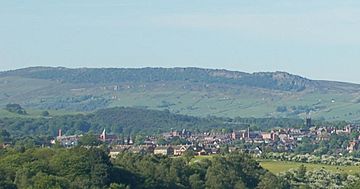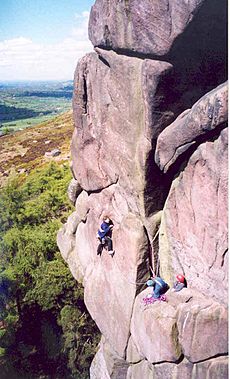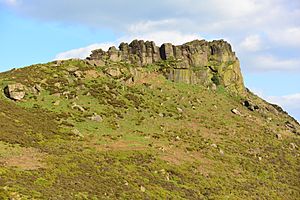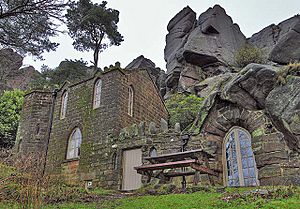The Roaches facts for kids
Quick facts for kids The Roaches |
|
|---|---|
 |
|
| Highest point | |
| Elevation | 505 m (1,657 ft) |
| Prominence | c. 120 m (394 ft) |
| Parent peak | Shining Tor |
| Listing | Dewey |
| Geography | |
| Location | Staffordshire, England |
| Parent range | Peak District |
| OS grid | SK001638 |
| Topo map | OS Landranger 119110 |
The Roaches is a famous rocky area in the Peak District, England. Its name comes from the French word les roches, which means 'the rocks'. This rocky ridge stands tall at about 505 meters (1,657 feet) above places like Leek and Tittesworth Reservoir.
The Roaches, along with Ramshaw Rocks and Hen Cloud, form a big, steep rock face. This rock is a strong type of sandstone called gritstone. The area is very popular for outdoor activities like hiking, rock climbing, and freerunning. It can get quite busy, especially on weekends!
The Peak District National Park bought The Roaches area, including Hen Cloud, in the 1980s. They wanted to protect it from building and keep it natural. Since May 2013, the Staffordshire Wildlife Trust has been looking after The Roaches Estate.
On clear days, you can see far across Cheshire. You might even spot Snowdon in Wales or Winter Hill in Lancashire. The Roaches are the most noticeable part of a long, curving ridge. This ridge stretches for several miles from Hen Cloud in the south to Back Forest and Hangingstone in the northwest.
At the very top of The Roaches, there is a small pool called Doxey Pool. People say a water spirit lives there! Nearby, you can also find the wide hills of Gun and Morridge.
Contents
How The Roaches Were Formed
The Roaches, Hen Cloud, and Ramshaw Rocks are made from a thick layer of coarse sandstone. This rock is called 'gritstone'. It formed a very long time ago, between 315 and 326 million years ago. This type of rock is found all over the Peak District.
The gritstone here is named the Roaches Grit because it's so common in this spot. Another nearby area, the Five Clouds, is made from a thinner layer of similar sandstone. These sandstones were once sands dropped by huge rivers. These rivers flowed from a mountainous land to the north, forming deltas.
The rock layers at both The Roaches and Hen Cloud tilt gently downwards to the east. This tilt is part of a large geological fold called the Goyt Trough. At Ramshaw Rocks, the same layers tilt steeply to the northwest. The southern end of The Roaches is marked by a fault (a crack in the Earth's crust). This fault runs through the low area that separates The Roaches from Hen Cloud.
Wildlife at The Roaches
The Roaches is home to interesting wildlife.
Wallabies
In the 1930s, five Australian Bennett's wallabies were set free from a private collection. These wallabies are like small kangaroos. A group of them lived in the wild here for many years, even into the 21st century. However, it's thought that this group might not exist anymore.
Peregrine Falcons
In 2008, a pair of peregrine falcons successfully raised their young on The Roaches. Peregrine falcons are very fast birds of prey. Because of this, climbing was stopped on part of the rock face for a while to protect the birds. Since then, the peregrine falcons have continued to have successful hatchings. Sadly, there have been times when eggs or young birds were stolen from their nests.
Doxey Pool Legend

Doxey Pool (sometimes spelled Docksey) is a small pond at the top of The Roaches. It measures about 15 meters (49 feet) by 10 meters (33 feet).
There's a local legend about this pool. People say it's home to a mermaid named Jenny Greenteeth, also known as the blue nymph. The story goes that she fell into the pool on a foggy day while walking along the top of The Roaches. Ever since, she has been trying to trick people into coming to the pool. The legend says she tries to pull them into the water to their watery grave.
The Winking Man Rock
The Winking Man Rock formation is a cool part of the Ramshaw Rocks section of The Roaches. It's also called the Winking Eye. You can see it from the main road (A53) between Leek and Buxton, about 5 miles outside Leek.
It looks like a face sticking out of the hillside. As you drive past it in a car towards Buxton, the 'eye' seems to wink! This happens because a tall rock pillar moves behind the 'face' as you drive. It's an optical illusion called parallax.
Don Whillans Memorial Hut
The Roaches is also where you'll find the Don Whillans Memorial Hut. This hut is also known as Rockhall Cottage. It's a special place for climbers and hikers.
Images for kids




